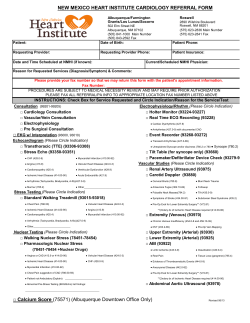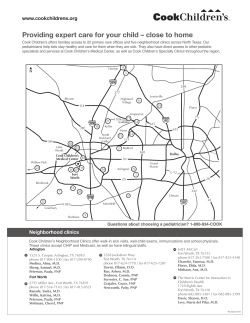
Syncope Syncope –– Workup, Diagnosis, Workup, Diagnosis, y
Syncope – Syncope y p – Workup, Diagnosis, p, g , Treatment Adrian Almquist, MD, FACC Minneapolis Heart Institute® at Abbott Northwestern Hospital h l Syncope: A Symptom, Not a Diagnosis Self Self--limited Relatively Variable loss of consciousness and postural tone rapid onset warning symptoms Spontaneous, complete, and usually prompt recovery without medical or surgical intervention Underlying mechanism: transient global cerebral hypoperfusion. Cardiovascular Core Curriculum Conference 11/16/2012 Allina Hospitals & Clinics, Minneapolis Heart Institute Foundation 1 When a person collapses but quickly recovers, it i is called fainting or syncope. When he dies ll d f i ti Wh h di within the next few minutes, it is called sudden or instantaneous death. George L. Engel, MD Psychologic stress Vasodepressor (Vasovagal) Psychologic stress, Vasodepressor (Vasovagal) Syncope, and Sudden Death. Annals of Internal Medicine, 1978. • LF 42 yr old male presented with syncope • Pt was in the bathroom having a bowel movement when he lost consciousness. Wife t h h l t i Wif found him sitting on the stool leaning to his right. He then collapsed to the floor and was unconscious for about 2 minutes. Not breathing and turned blue. Then suddenly woke up Paramedics called and transported woke up. Paramedics called and transported to local ER. Cardiovascular Core Curriculum Conference 11/16/2012 Allina Hospitals & Clinics, Minneapolis Heart Institute Foundation 2 Transient Loss of Consciousness Trauma--induced Trauma Concussion Not TraumaTrauma-induced Not True TLOC TLOC mimicks, without true loss of consciousness e.g., g • Syncope • Seizures • Intoxications • Metabolic disorders • psychogenic “pseudo pseudo-syncope” syncope ” • ‘drop attacks’ attacks’ • cataplexy Causes of True Syncope NeurallyMediated Reflex Orthostatic 1 • VVS • CSS • Situational Cough g Post- 2 • DrugInduced • ANS Failure y Primary Seconda ry micturition 60% 15% Cardiac Arrhythmia 3 • Bradycardia Sinus pause/arre st AV block • Tachycardia VT SVT 10% • LongQT Synd Structural CardioPulmonary 4 • Aortic Stenosis • HCM • Pulmonary Hypertensi on • Aortic Dissection 5% Unexplained Causes = Approximately 10% Cardiovascular Core Curriculum Conference 11/16/2012 Allina Hospitals & Clinics, Minneapolis Heart Institute Foundation 3 • For 2 months prior to this episode he had noted a few episodes of fluttering in his chest. No lightheadedness, some mild chest discomfort. discomfort • No previous episodes of syncope. • No history of heart disease, hypertension, DM, hyperlipidemia. Father has CAD. • Hx of kidney stones Hx of kidney stones • PE: HR 78, BP 124/78, no orthostatic drop cardiovascular exam: no murmur • CXR: mild cardiomegaly; EKG www.escardio.org/guidelines Cardiovascular Core Curriculum Conference 11/16/2012 Allina Hospitals & Clinics, Minneapolis Heart Institute Foundation 4 • Coronary angiogram: normal • Left ventriculogram: EF 60%, no WMA Left ventriculogram: EF 60% no WMA • Echocardiogram: normal • DX: Vasovagal syncope Cardiovascular Core Curriculum Conference 11/16/2012 Allina Hospitals & Clinics, Minneapolis Heart Institute Foundation 5 QUESTION ? Is vasovagal syncope the correct diagnosis ? A. Yes B. No 87% 13% A. B. Fig 1 Causes of syncope by age. Parry S W , Tan M P BMJ 2010;340:bmj.c880 ©2010 by British Medical Journal Publishing Group Cardiovascular Core Curriculum Conference 11/16/2012 Allina Hospitals & Clinics, Minneapolis Heart Institute Foundation 6 “First let’s make sure you don’t die.” Syncope, Part 1‐ Cardiac Syncope, About.com Richard Fogoros, MD Two weeks later he sustained a cardiac arrest. EMTs found him in ventricular fibrillation No evidence of myocardial infarction No evidence of myocardial infarction Successfully resuscitated; transient anoxic encephalopathy. • Transferred here for further evaluation. • • • • Cardiovascular Core Curriculum Conference 11/16/2012 Allina Hospitals & Clinics, Minneapolis Heart Institute Foundation 7 • Echocardiogram: Mild RV enlargement, LV normal • Right heart cath: normal pressures, RV gram showed a dilated hypokinetic RV • EPS: Nl AV conduction Inducible monomorphic VT, CL 260 ms LBBB with inferior axis morphology Conventional EP Testing in Syncope Most useful in structural heart disease patients Useful diagnostic observations: • Inducible monomorphic VT • SNRT > 3000 ms or CSNRT > 600 ms • Inducible SVT with hypotension • HV interval ≥ 100 ms (especially in absence of inducible VT) • Pacing induced infra infra--nodal block Brignole M, et al. Europace Europace.. 2004;6:4672004;6:467-537 537. Cardiovascular Core Curriculum Conference 11/16/2012 Allina Hospitals & Clinics, Minneapolis Heart Institute Foundation 8 • Endomyocardial bx: granulomas without necrosis • DX: cardiac sarcoidosis DX: cardiac sarcoidosis • Still inducible on AA drug therapy • ICD system placed by sternotomy Impact of Syncope on Mortality Risk V Vasovagal l Syncope S has h low l mortality risk • But recurrences are a concern Syncope of presumed cardiac cause is associated with high mortality risk • Most evidence suggests that risk is similar to that of patients without syncope but with similar severity of heart disease Soteriades ES, Evans JC, Larson MG, et al. Incidence and prognosis of syncope. N Engl J Med. 2002;347(12):878-885. [Framingham Study Population] Cardiovascular Core Curriculum Conference 11/16/2012 Allina Hospitals & Clinics, Minneapolis Heart Institute Foundation 9 • History and physical: probably the most important part of the evaluation • History from pt and witnesses • Circumstances, time of day, last meal Circumstances time of day last meal • Prodrome, palpitations, position,etc • Prior syncope • Medications • Family hx of syncope or sudden death Family hx of syncope or sudden death • Review ambulance run sheet, particularly VS Cardiovascular Core Curriculum Conference 11/16/2012 Allina Hospitals & Clinics, Minneapolis Heart Institute Foundation 10 • Physical exam: Supine and upright BP and pulse Check upright BP and pulse every minute X Check upright BP and pulse every minute X 3 • Check for carotid bruits, cardiac murmurs, signs of CHF, PVD, etc • Brief neurologic exam g EKG Rhythm strip if ectopy present Rhythm strip if ectopy present Cardiovascular Core Curriculum Conference 11/16/2012 Allina Hospitals & Clinics, Minneapolis Heart Institute Foundation 11 High Diagnostic Yield and Accuracy of History, Physical Examination, and ECG in Patients with Transient Loss of Consciousness in FAST: The Fainting Assessment Study Journal of Cardiovascular Electrophysiology Volume 19, Issue 1, pages 48-55, 3 OCT 2007 DOI: 10.1111/j.1540-8167.2007.00984.x http://onlinelibrary.wiley.com/doi/10.1111/j.1540-8167.2007.00984.x/full#f2 • 32 year old male in EMT training program referred by a neurologist for a tilt study • Three episodes of syncope during classes, all proceeded by a feeling of feeling warmth proceeded by a feeling of feeling warmth, then rapid LOC. • Received CPR during two of the episodes; AED also applied during two of the episodes with command of “continue CPR.” • A little groggy after the event; incontinent with two episodes. Seizure like activity described by fellow students during the events. Cardiovascular Core Curriculum Conference 11/16/2012 Allina Hospitals & Clinics, Minneapolis Heart Institute Foundation 12 • Admitted with the first episode, neurologic evaluation. Felt to have seizure disorder, treated with anticonvulsants. • Episodes reoccurred. Episodes reoccurred • PMH: two episodes of fainting as a teenager, otherwise unremarkable. No medications prior to first event. No FH of heart disease or SCD. • PE: Unremarkable • EKG nl How Not to Evaluate Syncope1 Low Yield, High Cost • CT scan • Carotid dopplers • EEG • Neurology consult – 0-4% diagnostic yield2,3 (head CT scan, carotid Doppler) • Psychiatric consultation • Cardiac enzymes 1Olshansky B. In: Grubb B and Olshansky B. eds. Syncope: Mechanisms and Management. Futura. 1998:15-71. Kapoor W. Medicine. 1990;69:160-175. 3 Kapoor W. JAMA. 1992;268:2553-2560 2 Cardiovascular Core Curriculum Conference 11/16/2012 Allina Hospitals & Clinics, Minneapolis Heart Institute Foundation 13 Diagnostic Studies That Demonstrated the Cause of Syncope. Kapoor WN et al. N Engl J Med 1983;309:197-204. QUESTION ? What is the best test to evaluate this patient? ti t? A. Tilt test B. External event monitor for 2 weeks C. EP study D. Implantable loop recorder 52% 24% 21% 3% A. Cardiovascular Core Curriculum Conference 11/16/2012 Allina Hospitals & Clinics, Minneapolis Heart Institute Foundation B. C. D. 14 Heart Monitoring Options Syncope Occurs Infrequently, Long--term Monitoring is Likely to be Most Effective Long 12--Lead 12 Holter Monitor Typical Event Recorder MCOT External Loop ILR Recorder 10 Seconds 2 Days 7 Days 30+ Days y 36 Months ILR = insertable loop recorder MCOT= mobile cardiac outpatient telemetry Eastbourne Syncope Assessment Study EaSyAS 1 Conventiona l ILR D. Farwell. Eur Heart J 2006; 27: 351-356 Cardiovascular Core Curriculum Conference 11/16/2012 Allina Hospitals & Clinics, Minneapolis Heart Institute Foundation 15 Cardiovascular Core Curriculum Conference 11/16/2012 Allina Hospitals & Clinics, Minneapolis Heart Institute Foundation 16 • Tilt study: 70 degree HUT for 30 minutes BP, HR with Finameter Selective use of sublingual NTG • Findings: After about 9 minutes of tilt, pt developed warm Findings: After about 9 minutes of tilt pt developed warm sensation, mild diaphoresis. • Rapid slowing of sinus rate, then > 3 minutes of cardiac asystole, CPR started, atropine given. • Minimal decline in BP prior to the asystole. • Recovered quickly post event. • DX: “Malignant vasovagal syncope” NMS:Clinical Pathophysiology Neurally Neurally--mediated physiologic reflex mechanism with two components: • Cardioinhibitory ( HR ) • Vasodepressor Both ( BP ) components are usually present: • Vasodepressor may be masked in the presence of severe bradycardia • Pace or prepre-treat with atropine in order to observe Vasodepressor component Cardiovascular Core Curriculum Conference 11/16/2012 Allina Hospitals & Clinics, Minneapolis Heart Institute Foundation 17 www.escardio.org/guidelines Figure 1. Flow chart for the diagnostic approach to the patient with syncope. Strickberger S A et al. Circulation 2006;113:316-327 Copyright © American Heart Association Cardiovascular Core Curriculum Conference 11/16/2012 Allina Hospitals & Clinics, Minneapolis Heart Institute Foundation 18
© Copyright 2025





















